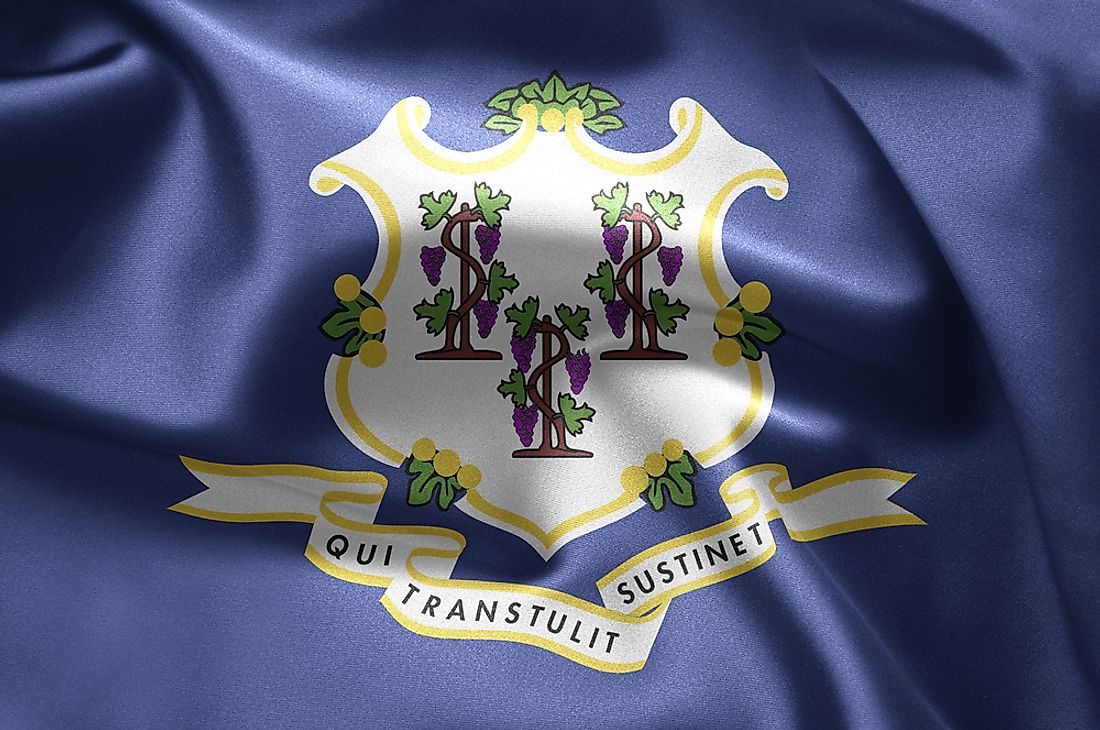Connecticut State Flag

Connecticut State Flag
The Connecticut state flag is rectangular with a central grand baroque shield. The baroque shield features three grapevines. On each of the three grapevines are three bunches of purple grapes. The borders of the shield are decorated with gold and silver.
Beneath the baroque shield is a white ribbon bearing a cleft at both ends. The ribbon is flanked in brown and gold. The ribbon contains the inscription in Latin, ‘Qui Transtulit Sustinet,’ which is the motto of the state of Connecticut. When translated into English, the motto stands for ‘He who transplanted still sustains.’ The motto is derived from the Bible in the 80th Psalm. The motto on the ribbon is written in dark blue color.
The current flag of Connecticut is 1.7 meters long and1.32 meters wide. The ratio of its length to width is 3:4.
Symbolism of the Flag
The three grapevines in the white baroque shield represent the three vibrant colonies of Connecticut, New Haven, and Saybrook. The three grapevines also symbolize the first three towns that were founded by Europeans; Hartford, Wethersfield, and Windsor. The grapes symbolize the fellowship, peace, and liberality that come with the abundance of wine and wine-making.
The blue color in the background of the flag is a symbol of wealth, truth, perseverance, loyalty and vigilance. The white color represents peace and honesty, while the yellow or golden color symbolizes generosity, wealth, and the sun.
History of the Flag
The first design of the current flag of Connecticut was displayed at the American Revolution from 1775 to 1783. The background of the flag was red. In 1895, Owen Vincent Coffin, who was the then governor of Connecticut, passed a motion for the adoption Connecticut state flag. However, it was not until 1897 that the flag was approved by the Connecticut General Assembly giving it its official description and dimensions. The length of the approved flag was five feet and six inches while the width was four feet and four inches. The background was to be an deep blue silk. White silk was used in highlighting the armorial bearing. Silver and gold color would be used to embroider the perimeter of the shield. underneath the shield would lay a banner bordered in brown and gold, comprising of clefts at both of its ends and the state motto, ‘Qui Transtulit Sustinet’ written along it in dark blue.
The design of the flag is an imitation of the Saybrook colony seal. The seal of the Saybrook colony consisted of fifteen grapevines. Besides, the seal featured a hand in the upper left with a streamer written ‘Sustinet Qui Transtulit.’ The seal of Saybrook was brought to Connecticut in 1644 when the colony was bought by Connecticut. On October 25, 1711, the legislature of Connecticut lessened the number of grapevines in the seal to three, to stand for the three colonies: Connecticut, New Haven, and Saybrook. The wording in the ribbon beneath the shield was also rearranged from ‘Sustinet Qui Transtulit’ to ‘Qui Transtulit Sustinet.’ The flag was officially adopted on September 9, 1897.











